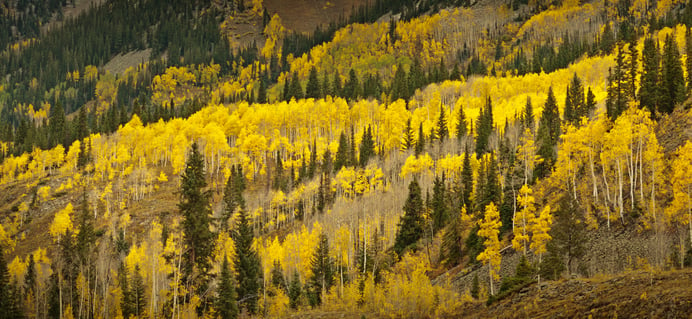A kaleidoscope of colors are about to be unlocked as we transition into autumn; ocean-blue oregon-grape at our feet, bright red thimbleberries ripe for the picking, and hillsides of golden aspens await. Where would you guess we are in our fall color spectrum? Colorado State University predicts that we are either “partially” or “very near” full peak for our fall colors. Which means it is the perfect time for us to brush up on our fall color science to really understand what is really going on in those golden hillsides.

A kaleidoscope of colors are about to be unlocked as we transition into autumn; ocean-blue oregon-grape at our feet, bright red thimbleberries ripe for the picking, and hillsides of golden aspens await. Where would you guess we are in our fall color spectrum? Colorado State University predicts that we are either “partially” or “very near” full peak for our fall colors. Which means it is the perfect time for us to brush up on our fall color science to really understand what is really going on in those golden hillsides.
 Different Aspen Leaf Colors
Different Aspen Leaf Colors
First, a quick revisit on some basic biology. Chlorophyll is the chemical that gives plants the ability to photosynthesize and their green colored leaves. Chlorophyll degrades in sunlight and so plants must use energy to replenish it in order to continue making food. As we creep towards the winter solstice our days get shorter and it no longer becomes efficient for all plants to continue making chlorophyll. Eventually, the shift in day length will begin to shut off chlorophyll production in some plants and the other colors hidden behind the green chlorophyll begin to emerge.
Carotenoids are a group of chemicals pigmented yellow and orange. These chemicals persist within the leaf all spring and summer. Their purpose is to aid in capturing light energy to help the process of photosynthesis but are not visible until chlorophyll fades. This group of chemicals is responsible for what we are seeing most fall color here in the mountains, in particular, they are key to those golden stands of aspen trees. Red and purple colors in leaves are caused by the chemicals, anthocyanins. These chemicals are also responsible for the red color in fruits such as thimbleberries. Anthocyanins require active production under specific environmental conditions. The purpose of anthocyanin production is not well understood yet, but it is caused by carbohydrates getting trapped in the leaves.
Not only chemicals control fall color. A variety of environmental factors including elevation, temperature, precipitation and other local weather conditions can impact how we experience fall foliage. Elevation determines when we see fall color change as it is linked to temperature. For every 1,000ft in elevation gained, temperature can decrease up to 5 degrees Fahrenheit. Meaning Vail, sitting at roughly 8,000ft, is often the crescendo in the valley for fall foliage first, with color cascading down to Avon, Eagle, and then Gypsum later. This is good news for us, as we can experience fall foliage for much longer with our topographical diversity! Sunshine and non-freezing temperatures are key to a long and luscious fall show. The best colors are seen when we have days of warm sunshine and nights that are cool, but not freezing. An early frost or heavy wind can strip the leaves from the trees before they have reached their peak color.

Golden Aspen Tree Hillside
Another environmental factor to consider is precipitation / moisture. One heavy rain storm can mean thousands of leaves drop early, contrastly, the soil requires moisture for months leading up to fall, so we need rains all spring and summer. Drought conditions can mean a shortage of fall colors because the leaves do not have the resources they need. Causing the leaves to go brown sooner.
With all this knowledge on fall color science, it leaves us with the ever persistent question of will we have a good show this year? The answer is we really do not know! There is still so much research to be done on trees and environmental conditions that we have no way of 100% accurately predicting what will happen. We do know that the beauty of nature is evolving constantly and we can enjoy what we have right now, each and every day.
To learn even more about Fall, join a Naturalist on a Fall Nature Walk.
What: Fall Nature Walk
When: Monday-Thursday 11:30-12:30 or Friday-Saturday 9-10am
Where: Vail Nature Center
Cost: FREE
For more info, call us at 9704792291
Byline: Tayler Branson is the Lead Naturalist at Walking Mountains Science Center and every fall she finds the show to be unbe-leaf-able!








